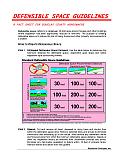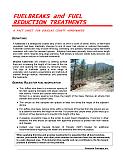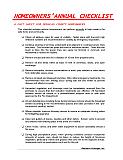Appendix D - Homeowner Guidelines
Homeowner Guidelines
Defensible Space Guidelines
Download the Defensible Space Guidelines fact sheet for Douglas County

(PDF, 170kb, 2 pages)
Fuelbreaks and Fuel Reduction Treatments
Download the Fuelbreaks and Fuel Reduction Treatments fact sheet for Douglas County

(PDF, 76kb, 1 pages)
Homeowner’s Annual Checklist
Download the Homeowner’s Annual Checklist fact sheet for Douglas County

(PDF, 41kb, 1 page)
Revegetation Specifications For Fuel Reduction Areas - East Slope, Carson Range
| Common Name | Scientific Name | Seeding Rate PLS pounds/acre | |
|---|---|---|---|
| Drill Application | Broadcast Application | ||
| “Sodar” Streambank wheatgrass | Elymus lanceolatus ssp. psammophilus | 1.50 | 4.00 |
| Sandberg bluegrass | Poa secunda | 0.25 | 1.00 |
| “Roadcrest” crested wheatgrass | Agropyron cristatum | 2.00 | 3.00 |
| “Secar” bluebunch wheatgrass | Pseudoroegneria spicata ssp. spicata | 1.00 | 2.00 |
| Blue flax | Linum lewisii | 0.25 | 0.50 |
| Prostrate summer cypress | Kochia prostrata | 1.00 | |
| TOTAL PLS POUNDS PER ACRE | 6.00 | 11.50 | |
| **Kochia prostrata should always be broadcast seeded on the soil surface, never drill seeded. | |||
Revegetation Specifications For Fuel Reduction Areas - Eastern And Southern Douglas County
| Common Name | Scientific Name | Seeding Rate PLS pounds/acre | |
|---|---|---|---|
| Drill Application | Broadcast Application | ||
| “Sodar” Streambank wheatgrass | Elymus lanceolatus ssp. psammophilus | 1.50 | 4.00 |
| Sandberg bluegrass | Poa secunda | 0.25 | 1.00 |
| “Roadcrest” crested wheatgrass | Agropyron cristatum | 2.00 | 3.00 |
| Bottlebrush squirreltail | Elymus elymoides | 1.00 | 2.00 |
| Prostrate summer cypress | Kochia prostrata | 1.00 | |
| Blue flax | Linum lewisii | 0.25 | 0.50 |
| TOTAL PLS POUNDS PER ACRE | 6.00 | 11.50 | |
| **Kochia prostrata should always be broadcast seeded on the soil surface, never drill seeded. | |||
This seed mixture is for treating all disturbed areas and areas cleared for fuel reduction purposes. Seeding application rates are specified on a “pure live seed” (PLS) basis. All seeds should be thoroughly mixed and seeded together at the same time. Drill seeding is recommended where feasible. Drill rows should be spaced as 12 inches apart and seed should be planted at a depth of 1/2 inch. Broadcast seeding is recommended for rocky, steep, or small treatment areas. The seed can be broadcast using hand held seeders such as a “Whirlybird” or a broadcast seeder mounted on an ATV. Continually mix the seed while seeding to equally distribute the small seeds throughout the mix. Following the broadcast seed application, seeded areas should be lightly raked to assure seed placement at an average depth of 1/2 inch. This can be done with hand held rakes, or by pulling a harrow implement or piece of chain link fence behind a truck or ATV in areas that are less rocky.
These guidelines are provided as overall recommendations. However, site-specific evaluation of the treatment areas by a specialist from a land management agency, the Natural Resources Conservation Service, or the University of Nevada Cooperative Extension will provide even greater assurance for success.
Thinning Guide
Thin Jeffrey Pine trees to reduce the stocking level to between 60 and 80 square feet of basal area per acre. Basal area of a tree is defined as the cross–sectional area at breast height (4.5 feet above the ground) and is expressed in square feet. A guide for the spacing needed for 80 square feet of basal area is, multiply a trees diameter breast height (in inches) by 1.7. The product will be the spacing in feet you should have between another tree of the same size. The following is a chart of tree sizes and the spacing needed between trees of the same size.
| Tree Diameter at 4.5 feet high (inches) |
Basal Area | |||
|---|---|---|---|---|
| 60 sq ft Dia. X 2 |
80 sq ft Dia. X 1.7 |
100 sq ft Dia. X 1.5 |
||
| 10 | 20 | 17 | 15 | Tree Spacing (ft.) |
| 110 | 147 | 183 | # Trees/Acre | |
| 12 | 24 | 21 | 18 | Tree Spacing (ft.) |
| 76 | 101 | 127 | # Trees/Acre | |
| 14 | 27 | 24 | 22 | Tree Spacing (ft.) |
| 56 | 74 | 93 | # Trees/Acre | |
| 16 | 32 | 28 | 25 | Tree Spacing (ft.) |
| 42 | 57 | 71 | # Trees/Acre | |
| 18 | 36 | 31 | 28 | Tree Spacing (ft.) |
| 33 | 45 | 56 | # Trees/Acre | |
| 20 | 40 | 34 | 31 | Tree Spacing (ft.) |
| 27 | 36 | 45 | # Trees/Acre | |
| 22 | 44 | 38 | 34 | Tree Spacing (ft.) |
| 22 | 30 | 37 | # Trees/Acre | |
| 24 | 48 | 41 | 37 | Tree Spacing (ft.) |
| 19 | 25 | 31 | # Trees/Acre | |
| 26 | 52 | 45 | 40 | Tree Spacing (ft.) |
| 19 | 25 | 31 | # Trees/Acre | |
| 28 | 56 | 48 | 43 | Tree Spacing (ft.) |
| 14 | 18 | 23 | # Trees/Acre | |
| 30 | 60 | 52 | 46 | Tree Spacing (ft.) |
| 12 | 16 | 20 | # Trees/Acre | |
- Remove the trees with forked tops. Forked topped trees can be become a hazard, as part of the top could fail and damage buildings, cars, and people.
- Remove trees with basal scars that are showing signs of wood boring insects and ants in the bole of the tree.
- Remove trees with dead or broken tops. These trees will attract bark beetles.
- Remove trees that are infested with dwarf mistletoe. If a tree only has dwarf mistletoe in the lower branches, then prune the branches off. Dwarf mistletoe is a parasitic plant that spreads by seed and will eventually kill the tree.
- Remove the smaller trees that are not in a dominant position in the canopy and are being crowded by the taller trees. Remove enough trees to all for ten to fifteen (10-15) feet of space between crowns. Jeffrey and ponderosa pine need direct sunlight to survive. Trees in a shaded condition will slowly die from lack of sunlight, but until they die, they will continue to use moisture and nutrients the larger trees could use. This stress for moisture in a overstocked condition will predispose all the trees to attacks from bark beetles, especially during years of drought.
- Treat the stumps with borax powder (decca hydrate borax) to prevent harmful root rot fungi (Fomes annosus) from becoming established.
- Thinning debris (limbs, tops and tree trunks) should be promptly removed from the site. Ips beetles will breed in wood larger than three (3) inches in diameter if the wood and slash remain on the site longer than four weeks. If the homeowner wants to keep the wood to burn in a fireplace, then the wood should cut to the proper length and split to help dry it out. Do not stack the wood between trees, next to buildings or under decks. Dispose of the limbs and tops by burning or chipping and hauling the chips away.
